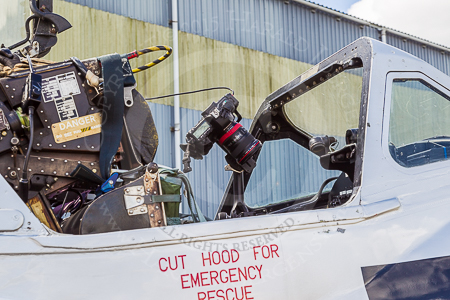Interactive 360° Cockpit Panorama
de Havilland Vampire T.11 (WZ507)

Customer:
The client is the Vampire Preservation Group, proudly supporting WZ507, at North Weald airfield in the UK..
Purpose:
The Vampire Preservation Group operates WZ507, one of the very few still flying Vampires anywhere inthe world (the only one in the UK) and one of the stars of the British air show scene, The interactive cockpit panorama allows anyone interested, especially spectators at an air show when WZ507 is flying, to explore the cockpit of this rare aircraft.
It should raise awareness about the task of keeping a 1952 fighter jet flying in the 21st century, and attract visitors to join the Supporter's Club, or even to become owner of a share of the aircraft.
Equipment used:
- Canon 5D Mark II with Really Right Stuff L-Plate
- Canon EF 17-40mm f/4L USM lens
- Really Right Stuff BH-55 ball head and Multi-Row Pano Elements Package
- Really Right Stuff carbon fibre monopod with MH-01 Pro monopod head for nadir shots
- Notebook computer with remote camera control software
How it was done: All photography has been done with the camera remotely controlled via a laptop computer. The main challenge have been the sun, creating very brightly lit areas as well as very deep shadows, way beyond the dynamic range of a modern digital camera. HDE (High Dynamic Range) processing was the only way to compress the extreme dynamic range. HDR processing made details, especially on the sides of the cockpit, clearly visible when it was difficult to see them clearly with the naked eye.
To have every detail in focus, from the closest to the lens to the furthest (almost infinite), focus stacking has been used. All photography has been done with available light only, using exposure bracketing. The combination of focus stacking and exposure bracketing means a large number of photos: The cockpit section is based on around 800 21-megapixel RAW images,
The resulting photos have been processed using focus stacking software. The resulting images have been edited, then stitched together, edited again, and then turned into a spherical panorama.
Technical information:
This Virtual Tour exists in two different versions: If HTML5 is supported by the browser, the HTML5 version will be used. In case HTML5 is not supported, and the Adobe Flash player is installed, the Flash version will be used.
The aircraft:
WZ507, UK registration G-VTII, is a two seat trainer version of the de Havilland jet fighter.
She was built 1952 by the de Havilland Aircraft Company at Christchurch, Dorset, and was delivered to the Royal Air Force in 1953, WZ507 served with 229 Operation Conversion Unit (OCU) in Chivenor, 8 Flight Training School (FTS) in Swinderby, 5 FTS in Oakington, 3 / 4 Civil Anti-Aircraft Co-operation Unit (CAACU) in Exeter, and Central Air Traffic Control School (CATCS) in Shawbury, before being retired from RAF service in 1969.
In 1980 WZ507 became the first ex-RAF jet fighter to be put onto the UK civilian register (as G-VTII), after being restored to full flying condition by the SAS.In 2005 the Vampire Preservation Group formed to operate WZ507 and preserve it as an airworthy aircraft.
Credits:
- Matt Hampton (Chief Pilot) for his work in compiling the long list of explanations
- Bev Steed (Ground Crew Chief) for his time and invaluable help
- the team of Weald Aviation Services Ltd. for getting the aircraft out of a full hangar, and back again afterwards
